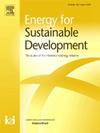Innovative low-cost approaches to biogas purification in developing economies
IF 4.9
2区 工程技术
Q2 ENERGY & FUELS
引用次数: 0
Abstract
The increasing environmental degradation and dependency on fossil fuels have accelerated the global push toward renewable energy. Sustainable Development Goal 7 underscores the critical role of clean, affordable energy in fostering social and industrial development. In developing regions, where organic waste is abundant, biogas—rich in methane—offers a viable renewable energy source. However, raw biogas contains impurities like carbon dioxide and hydrogen sulfide, reducing usability and requiring purification. Conventional purification technologies are often expensive, technologically intensive, and unsuitable for decentralized or small-scale applications in low-resource settings. This review evaluates low-cost, locally sourced materials for biogas purification suited to household and community-level systems. Several affordable materials show promising purification potential: clay removes up to 90 % of contaminants, iron-rich soils up to 93.8 %, steel wool about 95 %, and compost-based media around 80 %.
To further enhance these materials, the study suggests approaches such as drying biomass ash to reduce moisture content, modifying the surface chemistry of activated carbon to improve gas adsorption, combining multiple materials for synergistic effects, and reusing adsorbents to lower costs and environmental impact. Evidence from reviewed literature and pilot projects indicates that these low-cost materials can substantially reduce purification costs and operational burdens. Moreover, some have been successfully implemented in community-level biogas programs, improving energy access in underserved regions. These efforts align directly with the objectives of SDG 7, contributing to cleaner energy transitions and increased energy equity in low-income communities.
发展中经济体沼气净化的低成本创新方法
日益恶化的环境和对化石燃料的依赖加速了全球对可再生能源的推动。可持续发展目标7强调清洁、负担得起的能源在促进社会和工业发展方面的关键作用。在有机废物丰富的发展中地区,沼气——富含甲烷——提供了一种可行的可再生能源。然而,原始沼气含有二氧化碳和硫化氢等杂质,降低了可用性,需要净化。传统的净化技术往往昂贵,技术密集,不适合在资源匮乏的环境中分散或小规模应用。本综述评估了适合家庭和社区级系统的低成本、本地采购的沼气净化材料。几种经济实惠的材料显示出良好的净化潜力:粘土去除高达90%的污染物,富铁土壤去除高达93.8%,钢丝绒去除约95%,堆肥介质去除约80%。为了进一步增强这些材料,该研究提出了诸如干燥生物质灰以降低水分含量,改性活性炭表面化学以提高气体吸附,多种材料组合以产生协同效应,以及重复使用吸附剂以降低成本和环境影响等方法。经过审查的文献和试点项目的证据表明,这些低成本材料可以大大降低净化成本和操作负担。此外,一些项目已在社区沼气项目中成功实施,改善了服务不足地区的能源获取。这些努力直接符合可持续发展目标7的目标,有助于实现更清洁的能源转型,增加低收入社区的能源公平。
本文章由计算机程序翻译,如有差异,请以英文原文为准。
求助全文
约1分钟内获得全文
求助全文
来源期刊

Energy for Sustainable Development
ENERGY & FUELS-ENERGY & FUELS
CiteScore
8.10
自引率
9.10%
发文量
187
审稿时长
6-12 weeks
期刊介绍:
Published on behalf of the International Energy Initiative, Energy for Sustainable Development is the journal for decision makers, managers, consultants, policy makers, planners and researchers in both government and non-government organizations. It publishes original research and reviews about energy in developing countries, sustainable development, energy resources, technologies, policies and interactions.
 求助内容:
求助内容: 应助结果提醒方式:
应助结果提醒方式:


